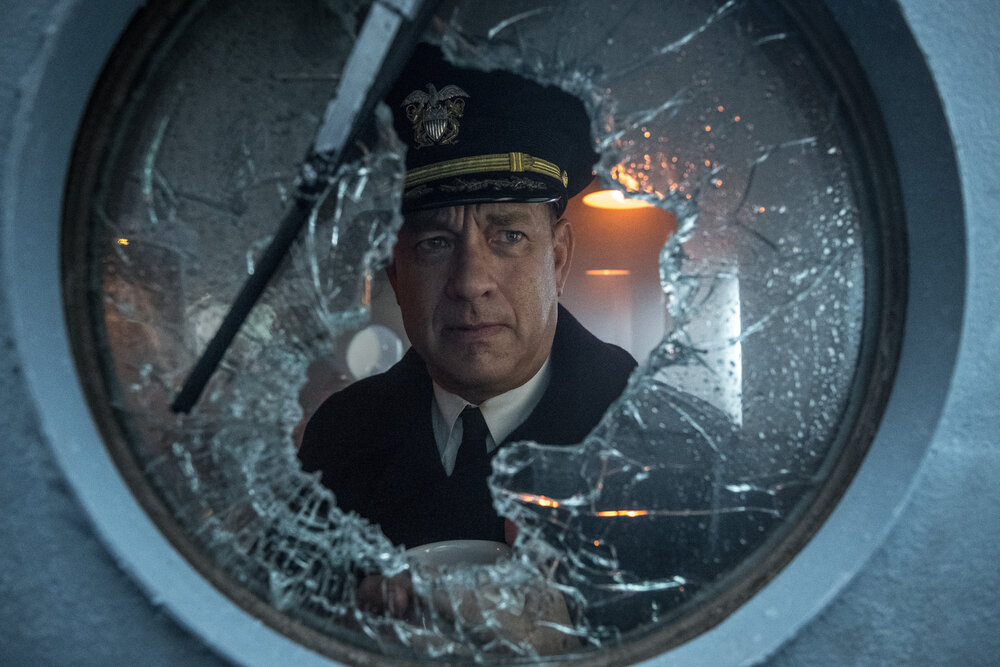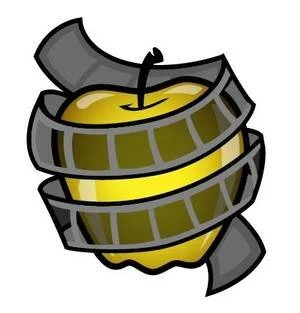
(Image courtesy of Apple and Sony Pictures Entertainment)
GREYHOUND— 4 STARS
There’s something to be said for a film that can constantly exude tautness. Some films will have stress and pressure, but not convey those traits with true tension. An element or two will have general solidity, but not have legitimate, durable steadiness. Like every battened down hatch on a warship cutting through its rough seas, the thrilling course of the new Apple+ Tom Hanks vehicle Greyhound throbs with tightness. Stutter, stumble or hesitate and a punctuating torpedo detonates your lack of focus.
Countless war films over the many decades of cinema cannot help but give way to the theatrical tendencies of the medium. They overindulge on explanations and extraneous dialogue exchanges to hold a viewer’s hand and fill the wait time between engagements. Moreso, frontline soliloquies and parapet speeches haul in bright humanistic spotlights that inflate dramatic license, even for fictional takes as well. Audiences eat those up because they are rightfully rousing for what they are, and there are places for those pedestals. Yet, the writers and filmmakers commonly forget or ignore that tautness comes from the situation as much as the men and women present. Well, Tom Hanks gets it and Greyhound churns without such typical trappings.
Based on C.S. Forester’s 1955 novel The Good Shepherd, this film relies on military meticulousness to fictionally emulate one American destroyer’s experience crossing the frosty North Atlantic as convoy protection for merchant vessels versus the marauding patrols of German U-boats. After a long non-wartime career prior to Pearl Harbor, Commander Ernest Krause (Hanks) leaves his wife Evie (a long-lost Elisabeth Shue) at Christmas in 1941 to take his first full command on the USS Keeling, bearing the titular nickname of the quick and lithe racing dog.
LESSON #1: THE IMPORTANCE OF THE BATTLE OF THE ATLANTIC-- For those light on their World War II history, Greyhound is a mere snippet of the lengthy Battle of the Atlantic. Wars can be won by the ability to replenish supplies and resources, making this is the battle to make further battles possible. Without reinforcing provisions and manpower arriving by sea from the United States and other countries, the embattled and blitzed island nation of Great Britain would have fallen. Escorting these cargo loads across the center stretch known as “The Black Pit” beyond the range of departure and arrival air cover was significantly vital. All told by the end of the war, over 3,500 ships would be sunk leading to over 72,000 deaths on both sides.
With the calendar turning to 1942, losses have become costly already. For this trek, the Greyhound is one of four light warships charged to protect 37 unarmed others with deck guns, depth charges, and early and imperfect forms of radar. When a hunting party of six U-boats favoring nighttime attacks arrive led by the howling “Gray Wolf” (voiced by Thomas Kretschmann on taunting and invasive radio transmissions), the Allies can only cover so much movement and find themselves helplessly watching ships being picked off and sunk to the deep under the glows of explosions and oil slick fires breaking up the dark and windy bluster.
LESSON #2: DOUBT IS AGELESS-- Seasoned in years, Ernest and his XO Charlie Cole (Stephen Graham of The Irishman) are merely rookies next to younger and more experienced British captains that have been at war for years already. Before going from a frosty frying pan into the frigid fire of the same icy waters that sunk the Titanic, all you have is your preparation. Education must turn into actionable skill, and doubt becomes the bigger opponent than the other armed combatant. The God-fearing Ernest’s answer to that challenge is the golden line from the film’s trailer: “Repetition will bring hell down from on high.”
LESSON #3: KNOW YOUR JOB AND FOLLOW ORDERS-- Terminology is exchanged between officers and specialists, demanding immediate compliance. Get it or you’re out. Orders are given and repeated back without any “but, sir” theatrics. Authority does not get challenged for the sake of drummed up emotional conflict. Calls for battle stations happen in a flash without lengthy establishing shots because real soldiers are ready a moment’s notice, period. Seconds separate the reaction time from success to failure. In those moments, soldiers shut up and get to work because their cooperation can mean life and death.
In Greyhound, there’s no time given for fluff or flourishes, not even an “I ain’t got time to bleed” retort to bone up a tough guy reality. Part of the film’s palpable sense of increasing tenacity is this lack of exposition. Outside of an ever-so-brief introduction of Shue, Greyhound propels forward for a swift and stunning 95 minutes. Weathering the unknown frenzy at the pace of the editing by The Shape of Water’s Sidney Wolinsky and My Big Fat Greek Wedding 2’s Mark Czyzewski is precisely the aim.
Strengthening the feel of Lesson #3, the deep research is very apparent. Between procedures, drills, bridge decorum, temperaments, command behavior, and the combined team efforts of the entire nautical operation, you will not find many more faithful reenactments of naval operations than what Tom Hanks has composed (his first screenplay since Larry Crowne) and Oscar-winning short film director Aaron Schneider has captured (his first feature in 11 years). Let the Smithsonian back up that praise.
The attention to detail on the production side is equally impressive. Knives Out production designer David Crank utilized interiors and exteriors of the retired and dry-docked USS Kidd in Baton Rouge, the last surviving WWII American destroyer, and the active HMCS Montreal for excellent scale and physical authenticity. Stellar cinematography by Shelly Johnson (Captain America: The First Avenger) and seamless CGI layers sent those hulls into the created warscape waves to dramatic effect. The tingling clincher is composer Blake Neely’s incredibly nerve-racking score. His piercing instrumental oceanic moans are as if he put those mechanical German howls through echo chambers of saltwater walls.
The common men receiving the actionified commands in Greyhound are an ensemble cast of virtually nameless subordinates played by the likes of Rob Morgan (Just Mercy), Karl Glausman (Love), Manuel Garcia-Ruflo (The Magnificent Seven), Tom’s son Chet, and the TV trio of Devin Druid (13 Reasons Why), Tom Brittney (Grantchester), and Lee Norris (One Tree Hill). For many viewers, their thinness will be a fair flaw, but that too matches working Navy actuality. Outside the increased dialogue announcements provided by Glausman’s radar man and a minute sageness given to Morgan as a somewhat planted, yet accurate, Black participant, all are there to pretty much stare and marvel at Tom Hanks and for good reason.
Shucking any and all Saving Private Ryan expectations in revisiting World War II on the silver (err, streaming) screen, the American acting hero crafts a different measure of resolve as the type of man who hits his knees before he hits his rack. For days, his skipper won’t leave, sit down, or even eat until safety is assured. Krause knows his men are watching and they need to see steadiness. The same can be said for the youngsters on set taking cues from the two-time Academy Award winner. The elder Hanks is a rock even while selling senior fatigue, anguish, and, most of all, mettle.
Sure, Greyhound is a simpler performance than the comparative likes of Captain Phillips and Sully, but Tom doesn’t miss a moment to matter. His Krause character’s favorite Bible verse just so happens to be Hebrews 13:8 which reads “Jesus Christ is the same yesterday and today and forever.” Putting him (and the hyperbolic love and ego of his devoted fans) in good company, that’s Tom Hanks too.

LOGO DESIGNED BY MEENTS ILLUSTRATED (#893)
from REVIEW BLOG - Every Movie Has a Lesson https://ift.tt/2ZBWZLa







No comments:
Post a Comment